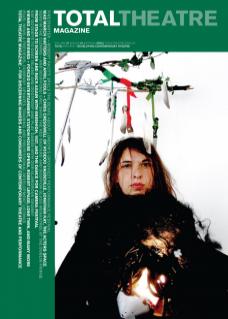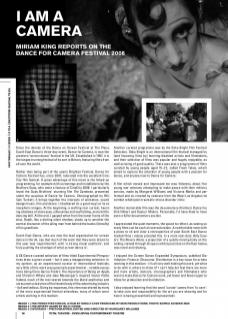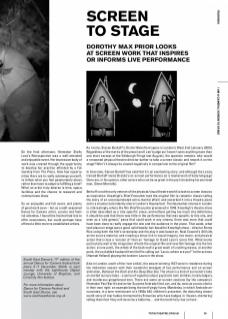Since the demise of the Dance on Screen Festival at The Place, South East Dance’s three-day event, Dance for Camera, is now the premiere ‘screen dance’ festival in the UK. Established in 1997, it is the longest running festival of its sort in Britain, featuring films from all over the world.
Rather than being part of the yearly Brighton Festival, Dance for Camera Festival has, since 2007, relocated into the excellent CineCity film festival. A great advantage of this move is the linked-up programming, for example with screenings and installations by the Brothers Quay, who were a feature of CineCity 2008. I particularly loved the Quay Brothers’ stunning film The Sandman, presented under the auspices of Dance for Camera. Choreographed by William Tuckett, it brings together the interests of animation, sound design/music, film and dance. I shuddered (in a good way) at its atmospheric images. At the beginning, a wafting rear curtain, haunting shadows of staircases, silhouettes and scaffolding, and a brittle dancing doll. At the end, I gasped when from the lower frame of the shot, Death, like a darting silent shadow, steals up to smother the central character of the ailing man from behind the backs (literally) of his guardians.
South East Dance, who are now the lead organisation for screen dance in the UK, say that much of the work that they were drawn to this year was ‘experimental’, with ‘a strong visual aesthetic’, and ‘truly pushing the envelope of what screen dance is’.
A SE Dance curated selection of films titled Experimental Perspectives drew a great crowd – but it was a disappointing selection. In my opinion, as an experienced curator of international festivals, very little of this work was genuinely experimental – notable exceptions being Clara Garcia Fraile’s The Importance of Being an Apple, and Chirstinn Whyte and Jake Messenger’s inspired Vector Paths. Indeed, much of the rest veered towards the bland aesthetics and unreconstructed view of the female body of the advertising industry – dull and tedious. Going by responses, this view was shared by many of the more experienced festival attendees, many of whom were artists working in this medium.
Another curated programme was by the Oska Bright Film Festival Selection. Oska Bright is an international film festival managed by (and featuring films by) learning-disabled artists and filmmakers, and their selection of films was popular and hugely enjoyable, as well as being of good quality. There was also a programme of films curated by young people aged 15–22, called Fresh Takes, which aimed to capture the attention of young people with a passion for dance, and anyone new to Dance for Camera.
A film which moved and impressed me was Veterans, about five young war veterans attempting to make peace with their military service, made by Margaret Williams and Victoria Marks and performed and co-created by veterans from the West Los Angeles VA combat rehab/post-traumatic stress disorder clinic.
Another memorable film was the documentary Krishna’s Dancer by Dirk Hilbert and Kasturi Mishra. Personally, I’d have liked to have seen a fuller documentary section.
I appreciated the quiet moments, the space to reflect, as seeing so many films can be such an oversaturation. A comfortable room with a place to sit and view a retrospective of past South East Dance funded films / videos provided this. In a room next door, Billy Cowie’s The Revery Alone, a projection of a quietly moving body on the ceiling, viewed through 3D specs whilst prostrate on the floor below, was novel and relaxing.
I enjoyed the Screen Dance Expanded Symposium, subtitled Distribution: Finance: Discourse. Distribution is a key issue for artists working in this medium – it’s all very well making the work, yet what to do with it, where to show it? I can’t help but feel there are more and more artists, dancers, choreographers and filmmakers who want to make Dance for Camera work, yet fewer and fewer opportunities for production and distribution.
I also enjoyed learning that the word ‘curate’ comes from ‘to care’: to take care and responsibility for the art you are showing and for how it is being presented (and represented).
On the final afternoon, filmmaker Shelly Love’s Retrospective was a well-attended and enjoyable event. Her impressive body of work was created through the opportunity to develop her practice afforded by a Fellowship from The Place. How few opportunities there are to really submerge yourself; to follow what you feel passionately about, rather than have to adapt to fulfilling a brief! What an artist truly desires is time, space, facilities and the chance to research and communicate ideas.
So an enjoyable and full event, and plenty of good work seen – but as a well-seasoned Dance for Camera artist, curator and festival attendee, I found this festival had lots to offer newcomers, but could perhaps have offered a little more to established artists.
South East Dance’s 11th edition of the annual Dance for Camera festival took place 5–7 December 2008, in partnership with the Lighthouse Digital Lounge, University of Brighton, and CineCity film festival.
For more information about Dance for Camera Festival and South East Dance, see www.southeastdance.org.uk


